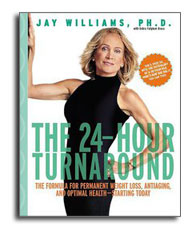
Fiber plays an important role in defining the way you look and feel, the status of your health and indirectly, the health of our planet. This calorie-free substance, found mainly in plant food sources, is mostly indigestible and passes through the digestive tract intact. Fiber also fills us up. How can you go wrong with a food that fills you up without adding extra calories? As a bonus, foods high in fiber speed up digestive processes, helping the body rid itself of waste products more quickly. Yet even though fiber gets a good rap, according to the Surgeon General reports, on average Americans eat only 10 to 15 grams of fiber a day. Your goal? 35 (or more) grams of fiber.
Why is 35 the magic number?
There are numerous reasons, all scientifically substantiated. For instance, we know that a low-fat, high-fiber diet reduces blood estrogen levels in women. We also know that women on high-fiber diets have a lower incidence of breast cancer. And studies show that a high-fiber diet keeps blood sugar levels balanced, resulting in less hunger and more weight loss.
In one study published in the New England Journal of Medicine, researchers compared the results from eating 24 grams of fiber each day with 50 grams of fiber. They reported that the weight of the participants and their daily calories did not vary between the diets, but the high-fiber diet led to a significant reduction in blood sugar levels. On average, blood sugar levels were 8.9 percent lower on the high-fiber diet. And as expected, the high-fiber diet reduced concentrations of cholesterol and triglycerides, important factors in cardiovascular disease.
In fact, a study from the Harvard School of Public Health revealed that with every 10 grams of fiber eaten, the risk of heart disease drops 20 percent. The Dr. Dean Ornish Spectrum Plan is a perfect example of a plant based diet that is high in fiber with a profound effect on health. Your well being is certainly worth another helping of broccoli or cabbage, isn't it? Other studies confirm the same: that a high-fiber diet benefits overall health, prevents disease and helps to maintain a normal weight. Here are just a few:
- A 1999 study at Northwestern University published in the Journal of the American Medical Association showed that a 10-gram increase in the daily intake of cereal fiber decreased the risk of heart attack by 29 percent.
- Studies in Hawaii have suggested that plant-based diets low in calories from fat, high in fiber, and rich in legumes (especially soybeans), whole grain foods, vegetables, and fruits reduce the risk of endometrial cancer -- a definite plus for women.
- Studies have shown that people who eat a high-fiber breakfast are not as hungry in the late afternoon as those who don't eat fiber in the morning. Soluble fiber, found in foods like oatmeal, barley, beans, and rye, slows the emptying of your stomach and your intestine. Your goal? Start your day with at least 6 or more grams of fiber for breakfast.
Fiber Content of Foods (listed from highest to lowest):
- Whole grains, including cooked cereals and breads from barley, oats, buckwheat, rice, rye, quinoa, spelt, wheat, and corn. Processed versions don't count, including processed flour.
- Legumes, including lentils, peas, and beans (including refried, no-fat, garbanzos on salad, and soy beans).
- Nuts, seeds, and dried fruits (high in calories; best to eat in moderation)
- Root vegetables, including yams, carrots, beets, and potatoes
- Other vegetables, including broccoli, green beans and leafy greens
- Fruit, including berries, pears, apples and prunes (juice has no fiber)
- Lettuce, cabbage, celery
- Meat, chicken, milk, cheese, eggs (contain NO fiber)
If you are not accustomed to a high-fiber diet, increasing fiber intake slowly will minimize any gas or bloating.
For more information on high fiber choices visit The Definition Diet at www.JayWilliamsPhD.com
Are you a sinker or a floater?
You can find the answer to that question in your toilet. Sinkers need a lot more fiber in their diet. Fill your diet with stone ground grains, nuts, fruits, vegetables and legumes to try to get your 35 fiber grams daily.
What is your transit time?
This test is not optional. At your next dinner, eat a large spoonful of corn kernels (frozen or fresh) and do not chew them. Or eat some fresh or canned beets. Watch for whole corn or deep red (from the beets) stool on the other end and determine your transit time:
- 10-18 hours: you have a healthy digestive system
- 18-24 hours: you need more water and fiber in your daily diet
- More than 24 hours: waste matter is sitting too long in your colon. Toxic substances that were supposed to be eliminated may be irritating your colon and getting absorbed back into your bloodstream. Once in the bloodstream, they are sent to all parts of your body and brain. You need increased fiber and water. If you are a carnivore, consider going without for a while and increasing your fresh vegetables, fruits, seeds, grains and legumes.
"Nothing will benefit human health and increase chances for survival of life on Earth as much as the evolution to a vegetarian diet."
--Albert Einstein

For more information and to order: www.JayWilliamsPhD.com